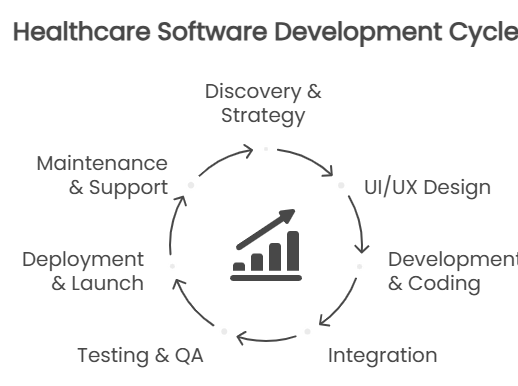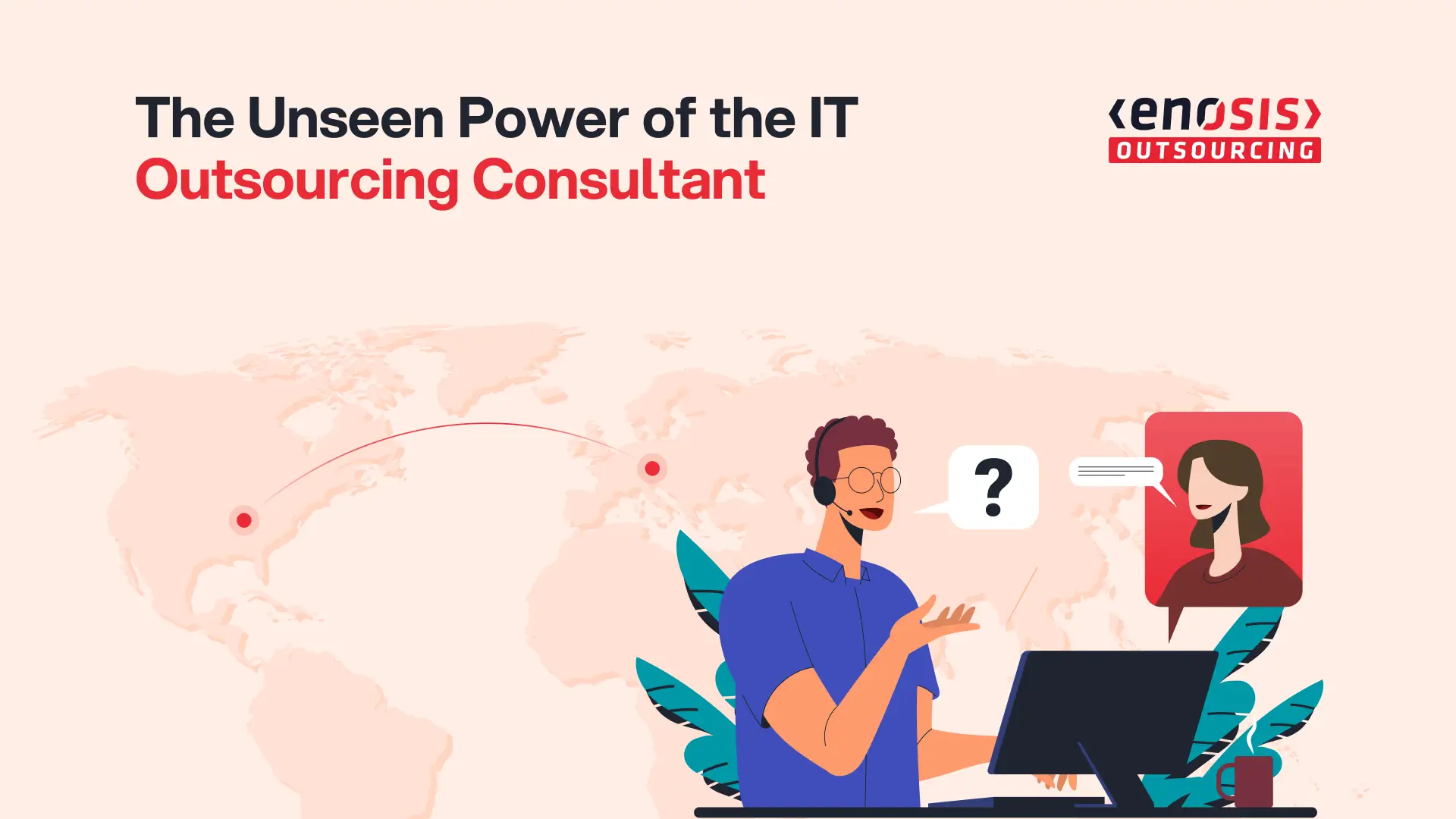Post Activity
 1006
1006
Table of Content
Share This Post
Table of Content
Imagine a world where your doctor predicts a health issue before it happens, or where a hospital visit feels as seamless as booking a flight online. This is the reality being shaped by custom healthcare software development.
According to HG Insights, the global healthcare IT market is projected to reach $279.5 billion by 2025, with North America accounting for 66% of total spending, primarily driven by the US market, which is expected to reach approximately $176.6 billion.
Deloitte Center for Health Solutions survey in 2025 found that nearly 60% of healthcare leaders hold a favorable outlook for the year ahead, up from 52% a year ago. This confidence is reinforced by 69% of respondents expecting revenue growth in 2025 and 71% anticipating improved profitability.
Generic and ready-to-go software is no longer enough. Today’s healthcare ecosystem requires software built for precision, platforms that streamline operations, empower patient experiences, and protect sensitive data with uncompromising security.
The Role of Custom Software in Healthcare
Healthcare has always relied on technology, but today it relies on software built to fit the way care actually works. Off-the-shelf systems once promised efficiency, but they often created more friction, like disconnected workflows, rigid interfaces, and costly workarounds.
For this reason, organizations are shifting to custom healthcare software development. Purpose-built solutions integrate seamlessly with clinical, financial, and administrative systems, enabling real-time visibility across the entire patient journey. They are designed to evolve with new regulations, technologies, and care models, making them the backbone of modern healthcare delivery.
The Healthcare IT Market Is Booming
The digital transformation of healthcare is accelerating faster than ever. The global healthcare IT market is projected to reach $981 billion by 2032, growing at a 15.7% CAGR as hospitals, insurers, and startups invest in smarter, connected systems.
North America continues to lead, accounting for roughly two-thirds of total IT spending, while Asia-Pacific is catching up with growth above 18% CAGR, driven by telehealth expansion and electronic medical record adoption.
Cloud and SaaS platforms remain the biggest catalysts. Healthcare SaaS alone is expected to nearly triple to $74.7 billion by 2030, reflecting a broader move toward flexible, subscription-based digital ecosystems.
For healthcare organizations, this surge is more than a technology trend. It is a signal to invest in systems built for scale, interoperability, and compliance. As budgets rise, many are turning to custom healthcare software development and outsourcing partnerships to accelerate delivery while maintaining quality and regulatory trust.
Thinking of Outsourcing?
Access a wide range of outsourcing companies and find your best fit.
Recent trends show that consumers are increasingly turning to the Internet for health-related insights. According to the U.S. CDC (July–December 2022), 58.5% of adults searched online for health or medical information, with women (63.3%) more likely than men (53.5%) to do so.
This highlights a critical reality: patients are no longer just open to digital healthcare, they actively expect it. From looking up medical information to accessing test results and communicating with doctors, consumers are driving healthcare toward a digital-first model.
In this landscape, custom healthcare software development plays a vital role. It bridges the gap between patient expectations and providers’ digital capabilities by delivering secure, user-friendly, and personalized solutions that enhance engagement and build trust.
Why These Data Points Matter
The surge in healthcare IT spending goes beyond digital transformation. It marks a strategic shift across the healthcare ecosystem. Hospitals, insurers, and technology providers are moving from volume to value, focusing on interoperability, patient experience, and data security.
As off-the-shelf tools lag behind evolving needs, custom healthcare software development is emerging as the smarter path. The market is not just growing; it is maturing and organizations that invest in adaptable, integrated platforms are set to lead the next decade of healthcare innovation.
Integrated: Benefits of Custom Healthcare Software
By aligning custom development with these data trends, healthcare organizations can:
- Build personalized patient portals that cater to diverse user groups (age, gender, ethnicity).
- Design telehealth and RPM platforms that support secure communication, tailored monitoring, and proactive care.
- Leverage cloud-based and SaaS architectures for scalable, compliant, and cost-effective deployment.
- Ensure inclusive design to enhance accessibility for underserved demographics.
To learn how outsourcing can accelerate this transformation while optimizing cost and compliance, explore The Ultimate Guide to Outsourcing Custom Software Development in 2025.
Emerging Trends in Healthcare Software Landscape
The healthcare software landscape is rapidly evolving. Beyond AI, IoT, and cloud computing, several other innovations are shaping the future of patient care and digital health delivery.
The healthcare software landscape is undergoing a transformative shift driven by cutting-edge technologies. Artificial Intelligence (AI) is enhancing diagnostics, automating workflows, and personalizing treatment plans. Internet of Things (IoT) and Internet of Medical Things (IoMT) are enabling real-time patient monitoring and remote care through connected devices, improving outcomes and reducing hospital visits. Cloud computing provides scalable infrastructure for storing electronic health records (EHRs), supporting telemedicine, and facilitating seamless collaboration among providers. Meanwhile, blockchain technology is emerging as a secure solution for managing sensitive health data, ensuring transparency, interoperability, and patient control.
Benefits for Various Stakeholders
1. Healthcare Providers
Custom healthcare software empowers providers with advanced diagnostic tools, intuitive dashboards, and seamless integration across EMRs, labs, and imaging systems. By reducing time spent on manual tasks, doctors and nurses can focus more on direct patient care. Decision support systems, powered by AI and predictive analytics, also help clinicians make faster and more accurate diagnoses, ultimately improving treatment outcomes.
2. Patients
For patients, custom software translates into personalized, accessible, and engaging care experiences. Whether through mobile health apps, patient portals, or telemedicine platforms, individuals gain more control over their health journeys. Features like appointment scheduling, medication reminders, and secure messaging make healthcare more convenient. Most importantly, patients feel empowered when they can easily access test results, educational content, and tailored treatment plans, all in one place.
3. Insurance Companies
Insurers benefit from streamlined claims management and fraud detection powered by custom analytics and automation. Tailored platforms can process claims faster, reduce errors, and identify fraudulent patterns before they escalate. Moreover, access to aggregated, anonymized population health data allows insurers to design smarter policies, improve risk assessment, and reduce operational inefficiencies.
4. Medical Device Companies
For device manufacturers, custom software integration adds significant value to hardware offerings. From wearables to imaging systems, software provides the intelligence layer that improves usability and outcomes. With analytics and reporting tools built in, devices become more than diagnostic instruments, they evolve into platforms for continuous health management and innovation.
Start Your Custom Software Project Today!
Partner with trusted outsourcing companies for custom software development and seamlessly elevate your business operations.
Challenges in Custom Healthcare Software Development
Even the most innovative healthcare software projects face critical challenges not because of technology alone, but because of the complex ecosystem they must integrate with. To deliver long-term value, every solution must balance security, interoperability, compliance, and scalability from day one.
Some of the most pressing challenges include:
- Data Security: Healthcare data remains one of the most targeted assets in the digital world. In 2024 alone, more than 124 million patient records were exposed in breaches. Meeting standards like HIPAA, GDPR, and ISO 27001 requires a proactive approach from encryption and access control to continuous security monitoring and regular audits.
- Integration with Legacy Systems: Many healthcare environments still operate on decades-old infrastructure. The challenge lies in modernizing without disrupting. Custom solutions must support FHIR and HL7 interoperability standards, ensuring seamless data exchange across EMRs, labs, and billing systems while reducing data silos.
- Rapid Technology Evolution: Innovation in AI, IoMT, and cloud platforms is reshaping the industry faster than most organizations can adapt. Building software on a modular, API-first architecture allows developers to integrate emerging technologies without costly rebuilds, creating flexibility for future innovation.
Real-World Case Studies
Several healthcare innovators are already demonstrating how tailored digital solutions translate into measurable impact.
- Evidence-Based Remote Physiotherapy Platform
ScienceSoft developed a custom platform enabling remote physiotherapy. The software incorporated data-driven treatment plans and real-time monitoring, leading to improved recovery outcomes and higher patient adherence rates.
- FDA-Cleared Neuroimaging Software
Itransition designed a UX-driven neuroimaging solution that achieved FDA clearance. The tailored software streamlined workflows for radiologists, reduced diagnostic errors, and enhanced collaboration across departments.
- Patient Engagement via Mobile App
Intellectsoft’s XMEd app improved patient-doctor communication by integrating chat, video consultations, and health tracking. The result: better patient engagement and satisfaction scores.
These examples highlight how custom healthcare software development delivers measurable improvements in patient care and operational efficiency.
7 Steps Roadmap to Developing Custom Healthcare Software
- Discovery & Strategy: Define business goals, regulatory requirements, and user expectations. This phase sets the foundation for compliant, scalable software.
- UI/UX Design: Create intuitive, accessible interfaces tailored for clinicians, patients, and administrators to minimize learning curves and boost adoption.
- Development & Coding: Use agile sprints to build core modules, implement APIs, and ensure adaptability for future integrations.
- Integration: Connect seamlessly with existing systems such as EMRs, billing, and lab software using interoperability standards like HL7 and FHIR.
- Testing & QA: Conduct performance, usability, and compliance testing to validate security and data integrity before release.
- Deployment & Launch: Roll out the solution securely, train teams, and establish monitoring protocols for stability.
- Maintenance & Support: Provide ongoing updates, security patches, and feature enhancements to ensure long-term system reliability.

Designing User-Friendly and Compliant Software
In healthcare, design and compliance go hand in hand. A platform that is intuitive but insecure fails to earn trust, while one that’s compliant but hard to use slows adoption.
The most effective solutions combine both compliance-by-design and human-centered UX.
Importance of Regulatory Compliance
Healthcare software must meet stringent frameworks such as Health Insurance Portability and Accountability Act (HIPAA), GDPR, and ISO 27001, protecting sensitive patient data (ePHI) and ensuring audit readiness. Building compliance into the development process, from data encryption to access control, which prevents costly redesigns later and strengthens institutional credibility.
Customizable and Tailored Designs
User-friendly interfaces are now strategic assets. Tailored workflows and inclusive design empower clinicians, administrators, and patients to interact seamlessly across devices and roles. A clear UI/UX minimizes training time, boosts daily engagement, and drives measurable ROI in digital adoption.
Leading Companies in Custom Healthcare Software Development
As healthcare transforms through digital innovation, several companies stand out for their ability to build secure, compliant, and high-impact healthcare software.
These leaders combine deep technical expertise with proven experience across telemedicine, interoperability, and patient engagement platforms.
ScienceSoft
With over 35 years of industry experience, ScienceSoft delivers tailored healthcare applications, from EMR modernization to telemedicine and cloud-based tools. Their strengths lie in deep regulatory expertise (HIPAA, FDA, interoperability), AI-driven innovation, and a track record of thousands of successful projects across industries.
Appinventiv
Known for its forward-looking approach, Appinventiv leverages advanced technologies like AI, IoT, and blockchain to craft HIPAA-compliant solutions such as telemedicine platforms and diagnostics tools. They offer end-to-end services from ideation to deployment, ensuring a smooth journey from concept to product.
Simform
This digital engineering firm excels in cloud, AI/ML, and interoperability, especially HL7 and DICOM integrations. Simform builds everything from EMRs and telehealth platforms to IoT-powered clinical tools. Their emphasis on future-ready, scalable systems makes them a notable choice.
inVerita
Focused specifically on healthcare, inVerita delivers HIPAA-compliant, cloud-based platforms featuring AI, IoT, and even AR/VR. Highly rated for patient engagement, telemedicine, and clinical management tools, inVerita is known for seamless, security-first solutions.
Why These Companies Are Leading the Pack
These organizations succeed because they blend technical excellence with healthcare domain depth. Their work reflects where the industry is heading: data-driven, interoperable, and patient-centric.
Conclusion: The Future is Custom Healthcare
Healthcare is entering an era where technology no longer supports operations but it defines them. The organizations leading this shift are those building software that mirrors real clinical workflows, connects every point of care, and protects patient trust at scale.
Custom-built systems are enabling a more connected healthcare ecosystem: one where information moves securely, decisions are data-driven, and experiences are seamless for patients and professionals alike. The focus is moving beyond transformation toward long-term digital maturity systems that adapt to new care models, regulatory shifts, and emerging technologies without disruption.
The next phase belongs to providers, payers, and innovators who see software not as a product but as an evolving capability. By partnering with the right development teams and embracing design built for scalability and compliance, healthcare organizations can turn technology into their most reliable instrument for better outcomes and sustainable growth.
Find Your Perfect Software Outsourcing Partner
Unlock a world of trusted software outsourcing companies and elevate your business operations seamlessly.
Frequently Asked Questions (FAQ)
1. When should I choose custom software over an off-the-shelf solution?
You should choose custom software when you have unique workflows, specific compliance needs, or want a competitive advantage that generic software can’t provide.
Off-the-shelf (OTS) solutions are great for standard processes, but if you find yourself constantly creating workarounds for an OTS product, it’s time to consider a custom build. A custom solution is built to fit your operations perfectly, rather than forcing your operations to fit the software.
2. How much does custom healthcare software cost and how long does it take?
This is the most common question, and the answer is: it depends. A simple application could cost between $50,000 to $150,000 and take 4-6 months. A complex platform, like a custom EMR or a telemedicine solution with AI features, could range from $250,000 to over $1,000,000 and take 9-18 months or more.
Key factors influencing the cost and timeline include:
- Complexity of features
- Number of integrations with other systems (like EMRs, labs, and billing)
- Strictness of compliance and security requirements (e.g., HIPAA, GDPR)
- The size and location of the development team
3. How do you ensure the software is secure and HIPAA compliant?
Ensuring security and HIPAA compliance is non-negotiable and is a core part of the development process.
Key measures include:
- End-to-End Encryption: All patient data is encrypted both when it’s stored (at rest) and when it’s being transmitted (in transit).
- Access Control: Implementing role-based access ensures users can only see the information necessary for their jobs.
- Audit Trails: Logging all access and changes to patient data to ensure accountability.
- Secure Infrastructure: Using HIPAA-compliant cloud hosting services (like AWS, Azure, or Google Cloud).
- Regular Security Audits: Performing frequent penetration testing and vulnerability scans to identify and fix weaknesses.
4. Can custom software integrate with my current EMR/EHR system?
Yes, absolutely. Integration with existing Electronic Medical Record (EMR) or Electronic Health Record (EHR) systems is one of the most critical requirements. Developers use secure Application Programming Interfaces (APIs) and adhere to healthcare interoperability standards like HL7 (Health Level Seven) and FHIR (Fast Healthcare Interoperability Resources) to ensure your new custom software can seamlessly and securely communicate with your existing systems.
5. What happens after the software is launched? What about maintenance?
Launching the software is just the beginning. Post-launch, you will enter a maintenance and support phase, which is crucial for long-term success. This typically involves an ongoing agreement with the development company and includes:
- Technical Support: A dedicated team to help your staff with any issues.
- Regular Updates: Releasing security patches and software updates.
- Performance Monitoring: Continuously monitoring the application to ensure it runs smoothly.
- Bug Fixes: Quickly addressing any bugs that appear after launch.
- Future Enhancements: Planning and developing new features as your needs evolve.






